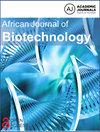Leaf microscopy, high performance liquid chromatography (HPLC) and gas chromatography-mass spectrometry (GC-MS) analyses of Croton zambesicus Mll.-Arg. leaf (Family: Euphorbiaceae) in Nigeria
引用次数: 0
Abstract
This study was done to get information on the chemical composition and the internal structure of the plant which could aid in its further characterization. The study is aimed at determining the epidermal leaf anatomy, HPLC of the hot water extract, chemical constituents of the oil from the leaves by GC-MS and chemo-microscopic properties of Croton zambesicus for proper identification of the plant. The leaf epidermal microscopy of C. zambesicus showed abundant trichome on the abaxial surface arising from a multi-cellular base and radiating radially and paracytic stomata were observed on the lower surface of the leaf. Chemo-microscopic analysis of the leaves showed the presence of cellulose, lignin, starch, oxalate crystals, tannin, oils, proteins and absence of mucilage. The physicochemical parameters evaluated on the leaves had moisture content of 4.10% and total ash value of 11.91%. HPLC analysis of the hot water extract revealed 12 peaks with number 3 having the highest peak of 93 mAU at 3.5 min. The GC-MS analysis of the oil of the leaves had 57 components. Caryophyllene had the highest percentage composition (15.53%) followed by Copaene (11.38%), Phellandrene (8.65%), 1,6-Octadien-3ol, 3,7-dimethyl (4.67%), Humulene (3.94%), Pinene (3.85%) and Ar-tumerone (3.41%).采用叶显微、高效液相色谱(HPLC)和气相色谱-质谱联用(GC-MS)技术对蚕豆进行分析。产于尼日利亚的叶子(科:大戟科)
本研究的目的是了解该植物的化学成分和内部结构,为进一步鉴定提供依据。本研究旨在通过对巴豆叶表皮解剖结构、热水浸提物高效液相色谱(HPLC)、叶油化学成分(GC-MS)和化学显微性质的测定,为巴豆鉴别提供依据。zambesicus的叶表皮显微镜观察发现,其背面有丰富的毛状体,起源于一个多细胞的基部,叶下表面有放射状和副吞噬的气孔。化学显微镜分析表明,叶片中含有纤维素、木质素、淀粉、草酸盐晶体、单宁、油脂、蛋白质,没有粘液。叶片理化参数测定结果表明,叶片含水量为4.10%,总灰分值为11.91%。热水提取物的HPLC分析发现12个峰,其中3号峰在3.5 min时达到93 mAU, GC-MS分析发现叶油有57个成分。石竹烯的比例最高(15.53%),其次是红烯(11.38%)、费蓝烯(8.65%)、1,6-八烯- 31醇、3,7-二甲基(4.67%)、葎草烯(3.94%)、蒎烯(3.85%)和Ar-tumerone(3.41%)。
本文章由计算机程序翻译,如有差异,请以英文原文为准。
求助全文
约1分钟内获得全文
求助全文

 求助内容:
求助内容: 应助结果提醒方式:
应助结果提醒方式:


